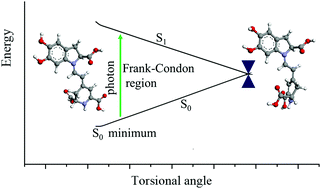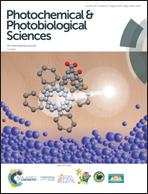Conical intersections and the weak fluorescence of betalains†
Abstract
Betalains are natural plant pigments found in certain plants belonging to the order Caryophyllales. This work presents theoretical calculations on the excited state properties of three betalains: betanin, an almost non-fluorescent natural betacyanin; indicaxanthin, a weakly fluorescent natural betaxanthin; and cBeet120, a synthetic betaxanthin fluorescence probe that is also weakly fluorescent. Calculations at the algebraic diagrammatic construction (ADC (2)) level of theory, combined with the conductor-like screening model (COSMO) to simulate solvent effects, predict absorption spectra in good agreement with experiment for all three of these betalains. Several distinct theoretical approaches identify torsions of the molecular geometry that can lead to conical intersections between the excited singlet (S1) and ground state (S0) potential surfaces and identify probable geometries at the minimum on the crossing seam (MXS). The present results thus emphasize the central role played by torsional modes in determining the fluorescence properties of natural betalains and of most synthetic betalain analogs as well. A direct implication of the results is that the fluorescence quantum yields of natural or synthetic betalains can potentially be enhanced by introducing structural modifications that permit the molecule to avoid these MXS geometries and/or by incorporation into a more rigid environment that hinders the specific bond rotations involved in the non-radiative relaxation of the excited state.



 Please wait while we load your content...
Please wait while we load your content...